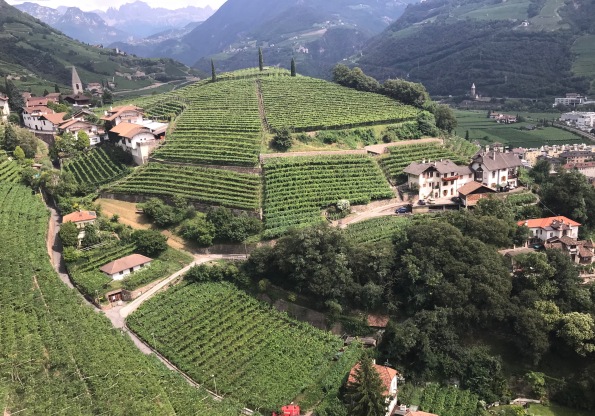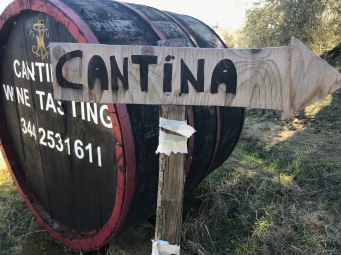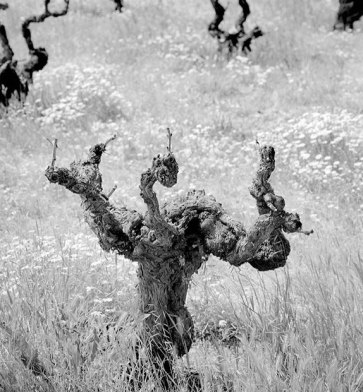Archive
What makes a wine great isn’t a number or a score

Steep hillside vineyards near Bolzano, Italy, illustrate the lengths to which wine makers will go to produce a memorable bottle of wine. Photos and story – Dave Buchanan.
Please indulge me while I share two separate conversations I heard recently.
The first from an acquaintance who recently returned from a late-fall trip to Napa Valley.
He and his wife, both discerning wine people with an appreciation for California-style wines, were visiting friends who introduced our couple to a fairly new but already successful winemaker.
During that initial conversation, the three quickly bonded and soon the winemaker was inviting his new friends to visit his winery, which normally isn’t open to the public. During a late lunch after touring his vineyards and winery, the winemaker graciously opened a couple of bottles from his personal library.
No sales pitch, no pressure, simply a gesture of friendship at our friends’ interest.
The wine, said my friend, “was a Cabernet (Sauvignon) and was simply stunning.”
Not surprisingly, at least to me, our well-funded friends brought a couple of these bottles back home to Colorado.
The second conversation, similar but with its roots 6,000 miles away, began when another acquaintance, this one a wine importer from Denver, remarked how he had met “too many to count” winemakers and their representatives while attending a wine festival in Verona, Italy.
“Almost everyone implored me to visit their winery and hear their story,” this friend recalled. So my friend, an impulsive sort, decided to take advantage of a couple of invitations.
“I saw some amazing estates and some tiny places where one family did all the work,” he said. “And mostly I tasted the same wines there that I tasted in Verona.”
But while sharing lunches and dinners in out-of-way bistros and private homes, he also got an insider’s peek at how Italians view their wines and its role in the everyday life. He gladly paid the extra baggage fees after being gifted a few bottles of Sangiovese-based Vino Nobile di Montepulciano.
Here is where our stories converge.

Nothing says ‘Welcome’ better than a friendly sign outside a neatly run winery.
Both men said that after arriving home, they invited over some friend to share the wines and hear their stories. And both, unknowingly but in similar words, told how the wines showed well but somehow something was missing.
“It’s not that the wines were less than great, they just weren’t that great, not like I remember,” said one.
“Everyone said nice things about the wine and were entertained to hear about how the winemaker’s grandfather had saved his wine from the Germans during World War II by hiding it under the stable,” said the other. “But to me, it just wasn’t the same wine.”
I was fortunate to taste both wines and both were way above what I normally drink. So it probably wasn’t the wines that were lacking. It was, both men affirmed, the experience of being there that made these wines memorable.
Seeing the vineyards, walking through the cellars, listening to the wine as it ages in the barrels, sharing a man’s or a family’s story. This, in great part, is what makes an unforgettable wine. Fortunately, both of these man realize that and neither is in any way disappointed by the wines.
“It’s always expectations versus reality,” one mused. “I know it won’t be the same once I get home but I want so much to share the experience.”
Today, social media (and extra baggage fees) allow us to share, from a distance both special and temporal, some of that experience. Still, it’s but a tantalizing taste of what wines are, what they can be, and what they mean to the people who make them.
What’s in the Glass: Ravenswood 2015 Belloni Vineyard Zinfandel
Ravenswood 2015 Belloni Vineyard Zinfandel – $39 MSRP. Lush, bright, rich with boysenberry, spice and loads of dark fruit. That’s the easy part.

These gnarled vines provide the lush fruit for Ravenswood’s Belloni Vineyard Zinfandel. Photo courtesy Ravenswood.
The story line on the Ravenswood website says winery founder Joel Peterson (is there a Zinfandel drinker who doesn’t know about Joel Petersen?) was first surprised and then enthusiastic when he initially saw the 90-year old vineyard Ricardo Belloni and his wife Natalia were farming in the Russian River Valley near Santa Rosa.
That was circa 1991 and ever since Peterson has used Belloni fruit to create deeply balanced and satisfying wines. While the 2015 vintage was challenging for most winemakers – drought and a cool spring (May average temperatures were reported below the January average) resulting in smaller crops – the Belloni vines provided a high-quality harvest. Drink now through 2025.
What’s in The Glass: #5 – 2018/Bonterra Organic Vineyards

Bonterra Organic Vineyards In Mendocino County, Cal., has produced organic and biodynamic wines since 1992. The winery’s three ranches are certified Biodynamic® by Demeter. Photo courtesy Bonterra Organic Vineyards.
There might still be some people who question why a winery would go through the effort to produced organic or biodynamic wines. Working without pesticides or synthetic fertilizers and chemicals requires more effort on the part of grapes growers and winemakers but the once you taste the purity and elegance of Bonterra Organic Vineyard’s lineup of wines, you’ll understand.
According to Bonterra’s founding winemaker Bob Blue, who got his jump into organic winemaking 31 years ago when he apprenticed under cult-status California winemakers Paul Dolan and Dennis Martin, “The key for making good wine is to have really healthy grapes.”
“We had the idea that if we farmed organically, we might make better wine,” Blue says in one of the winery’s promotional videos. “When we do organic, we get that balance in the vineyard.” The result, he says, is “the purest expression” of the grape.
It wasn’t easy at first, since even in the late ’80s few California winemakers understood the why or how of organic grape farming. Consumers, too, had to stretch their vision of what wine should be.
Today, “the consumers really appreciate what we do,” Blue muses in the video. “And we’ve achieved wines that are interesting and fun to drink.”
In 2017, Bonterra was recognized as American Winery of the Year at the annual Wine Star Awards ceremony hosted by Wine Enthusiast magazine.
Bonterra 2016 Pinot Noir – $18 SRP (media sample) Made with grapes sourced from home vineyards and from contract organic growers across Mendocino County, this firm-textured, fruit-forward wine offers initial aromas of strawberries, red currants and red raspberries and followed by flavors of more red fruits with a touch of oak, spice and vanilla.
Bonterra 2016 Viognier – $16 SRP (media sample). An initial flood of apricot and wine peach aromas are followed by flavors of more apricot, peach, green apple and orange blossoms. Fermented in both stainless (70%) and oak (30%) with another eight months in oak to add a bit of vanilla spice, this wine is sleek, firm and vibrant.
Bob Blue,,founding winemaker first wines in 1992
By then, Bonterra Organic Vineyards already had ben producing organic wines,
Today, Bonterra will be recognized as American Winery of the Year at the annual Wine Star Awards ceremony hosted by Wine Enthusiast magazine in Miami, Florida. It will be the first time the American Winery of the Year award is bestowed on a vintner dedicated to organic farming, and signals the blossoming acclaim and popularity of this once-niche segment of the wine landscape.
we’ve done so because we feel that organic grapes truly make the best wines,” said Jeff Cichocki, Bonterra Winemaker. “We were pioneers at the beginning of the organic movement, and we continue to evolve and lead with research into best practices for organic farming.
Why bio wines: more structural balance and require less manipulation during the vinification proces
What’s in the Glass – #4-2018

Tom Gore sums up his winemaking philosophy quite simply: Letting the character of the fruit shine through his well-balanced wines. Photo courtesy Tom Gore Vineyards.
A popular bumper sticker in my farm-to-table part of the country reads “Know farmers, know food.”
Take that a step farther and Tom Gore might say, “Know farmers, know wine.”
Gore prides himself on being a second-generation grape farmer in Sonoma County who several years decided to meld his love of farming with a vision of true-to-nature wines and began his self-named line of affordable, well-balanced wines.
His website recounts his farming and winemaking philosophy: “Great wines start with the work of a farmer” and Gore describes his lineup as “farm to glass” wines.
Here are the latest samples I’ve enjoyed:
Tom Gore 2015 Cabernet Sauvignon – $13. Aromas of dark cherries, currants and a hint of leather greet your nose while the mouth is filled lots of dark red fruits, dried red plums, sour cherries and black currants.
Soft tannins bolster the wine to a long finish of hints of faint cedar, dark chcolate and dried cherries and currants.
Tom Gore 2015 Chardonnay – $11. Fermented 60 percent in oak and 40 percent in barrel, this lively Chardonnay carries the best traits of both: a light oak styling brings depth to the fruit (a mix of yellow apple, pear and guava) while the stainless steel adds the right amount of tautness to balance the creamy underside of the oak.
What’s In The Glass – #2-2018

The Bovin Winery in the Tikvesh region of Macedonia. Photo courtesy of Bovin Winery.
Another in our continuing (albeit irregular) contributions about new openings. All prices are averages seen online or in local wine shops:
Bovin 2013 Cabernet Sauvignon, $12 – The Bovin winery is in the Tikvesh wine district of Macedonia, properly the Republic of Macedonia which formed after the 1991 breakup of Yugoslavia.
Winemaking goes back at least 4,000 years in the region and recently Macedonia’s wine industry has been pushing to gain more recognition.
Bovin has the capacity to produce 1.5-million bottles per year, which means producing various levels of wine to reach both regular and high-end consumers. I enjoyed the former and am intrigued about the latter.
I sampled the 2013 Cabernet Sauvignon made of 100 percent Cabernet Sauvignon grown 80 percent on winery owned vines and the rest sourced from regional growers. Full-bodied wine with an herby/earthy nose, lots of dark fruit (currants, blackberries and cherries) and soft tannins.
There also is a line of barrique-aged wines and a line labeled Superior, including (among other varieties) a Cabernet Sauvignon Barrique and a Cabernet Sauvignon Superior. More info on the website.
Imagery Chardonnay 2016, $16 – This pleasing blend of California-grown Chardonnay (95 percent) and Chenin Blanc (5 percent) is from Imagery’s new California tier of wines. The wine offers hints of apple and lime and pear with just enough oak to add some body and mouthfeel. The Chenin Blanc added some fullness for a fine mid-winter white wine.
Nothing wrong with Napa Valley Cabernet Sauvignon, except the price

(Photo courtesy Creative Commons)
Cabernet Sauvignon vineyards in Napa Valley command upwards of $300,00 per acre, especially when it means old vines, such as these at Chateau Montelena near Calistoga, Cal. High land prices is just one reason ultra-premium wines command premium prices.
The last time I encountered Rick Rozelle he was working the wine aisles at Fisher’s Liquor Barn in Grand Junction. The meeting wasn’t completely surprising since that’s where I usually find him, dispensing knowledge and turning on clients to good buys in wines.
This time he was doing something I’d heard him do before but always enjoy hearing – talking a customer out of a pricey top-shelf wine in favor of purchasing something more affordable yet just as tasty.
Once the client left, bottle in hand and smile on face, Rick and I spent a few minutes talking and he noted how many people look first to the top shelf, where you find the Screaming Eagles and Opus Ones of the wine world, as the starting point for what’s out there.
Nothing wrong with that, except that both those ultra-premium cabs will put a big dent in your bank account. On the online wine-searcher.com, a 2013 Opus One averages about $150 a bottle, “and you can get a whole lot of great wines for much less,” laughed Rozelle.

Finding the right Cabernet Sauvignon (or any wine) at just the right price often entails searching through a wall of wine. Photo by Dave Buchanan
On the whole, I consider most those upper-shelf Cabs over-priced, although that’s subjective to what you have in your pocket at the time, right?
“We’ve had people buy cases of it for weddings and stuff, so it’s not like it doesn’t sell,” Rozelle noted.
Cabernet Sauvignon remains “America’s most beloved red wine,” wrote Food & Wines eminent wine writer Ray Isle way back in 2005. “In 2009, California crushed almost 450,000 tons of Cabernet grapes, an amount roughly equal to one bottle per person for the entire U.S. population.”
One reason Cabernet Sauvignon still is so popular (it’s the second most-sold wine, period, right behind Chardonnay) is that among those millions of bottles are many selling for under $10, although you won’t find many really good California Cabs at that price.
You might find something from my colleague Jeff Siegel (www.winecurmudgeon.com) , who puts the cut-off line around $10 but has been known to inflate that number a bit when the wine is particularly good.
“Listen, it’s not easy finding cheap Cabernet Sauvignon that tastes like Cabernet Sauvignon,” said Siegel during the 2016 Colorado Governor’s Wine Competition for which he was a judge. “If there were, I’d drink more of it.”
He earlier wrote about Avalon Cabernet Sauvignon, which he described as offering the quality of Napa cabernet “at two-thirds to three-quarters of the price of comparable wines.”
The grapes aren’t Napa – they come from Lodi, Paso Robles, and Monterey County. Which is why Fisher’s Liquor Barn carries the 2014 vintage for under $10.
Siegel, who will return to Denver next month for the 2017 edition of the Governor’s Cup, wrote in a recent blog post that too many “value priced” Cabernets “are fruity and sticky, without the heft and tannins that cabernet is supposed to have— call them cabernet lite.”
“Or, if they taste like cabernet, they cost at least $20, and that’s not the point of what we do here,” Siegel wrote.
Why are Napa Cabernets so good, a fact that helps even inexpensive Cabernets from elsewhere succeed?

Some of the world’s best and most-desired Cabernet Sauvignon comes from Napa Valley. This Beaulieu Vineyard 2014 Napa Valley Cabernet Sauvignon is a value and can be found for as low as $25. Photo by Dave Buchanan
Simply, Napa Valley has the perfect climate and soils for growing the grape. But Napa Cabernet Sauvignon grapes are the highest-priced grapes in California, which means along with accelerating land costs ($300k-plus per acre), the price of a bottle of wine continues to grow.
Mike Fisher, on the blog Vinsights, wrote that grape costs should not exceed 25-percent of a wine’s selling price for a winery to experience a “reasonable profit.”
Because Napa grape costs are the highest in California, Fischer noted, virtually all red wine made with Napa grapes must be retail priced at $40 or more per bottle for the winery to receive a reasonable profit.
But wait. There are a lot of grapes being grown outside of Napa, and that’s where we should look for affordable Cabernet Sauvignon.
Paso Robles, Lodi, Monterrey, Central Coast, the list goes on of places where Cabernet Sauvignon thrives. And that’s just in California.
What about Washington, Chile and Italy?
Cheaper land plus cheaper grapes equal affordable and delicious California and California-quality Cabernet Sauvignon.
And if that’s not enough, Wines&Vines online recently quoted Tony Correia, a real estate appraiser and consultant from Sonoma, Cal., saying, “Any land that’s in Napa Valley, in the watershed of the Napa River, that can be planted to Cabernet and produce a good crop of Cabernet is being planted today, and they can make a call and sell the fruit for $5,000, $6,000 $7,000” per ton.
That’s about 3.5 times what those grapes cost in 1995, when the average price per ton was $2,000.
One more thing. One reason some of the ultras are so ultra is cachet. People want to feel important and have other people say nice things about them and one way to impress is to pour a wine everyone knows cost a king’s ransom.
“But that’s not what we’re here for,” to repeat Siegel’s riposte.